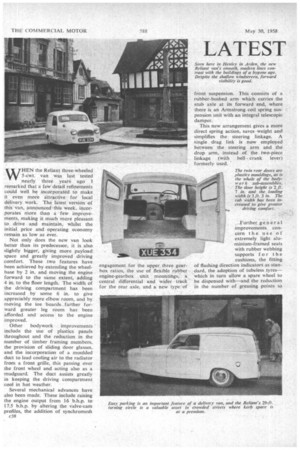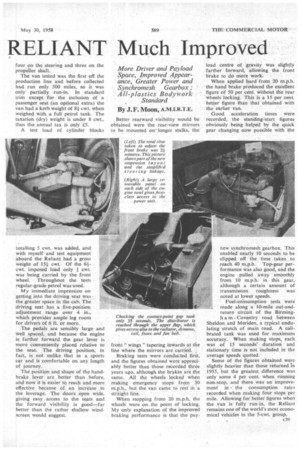LATEST RELIANT Much Improved
Page 76

Page 77

Page 78

If you've noticed an error in this article please click here to report it so we can fix it.
WHEN the Reliant three-wheeled 5-cwt. van • was last tested nearly three years ago I remarked that a few detail refinements could well be incorporated to make it even more attractivefor local delivery work. The latest version of this van, announced. this week, incorporates more than a few improvements, making it much more pleasant, to, .drive and maintain, whilst the initial price and operating economy remain as low as ever.
Not only does the new van look better than its predecessor, it is also slightly bigger, giving more payload space and greatly improved driving comfort. These two features have been achieved by extending the wheelbase by 2 in. and moving the engine forward to the same extent, adding 4 in. to the floor length. The width of the driving compartment has been increased by some 6 in. to give appreciably more elbow room, and by moving the toe 'boards,farther forward greater leg room has been afforded and access to the engine i improved.
Other bodywork improvements include the use of plastics panels throughout and the reduction in the number of timber framing members, the -provision of sliding door glasses, and the incorporation of a moulded duct to lead cooling air to the radiator from a front grille, this passing over the front wheel and acting also as a mudguard. The duct assists greatly in keeping the driving compartment cool in hot weather.
Several mechanical advances have also been made. These include raising the engine output from 16 .b.h.p. to 17.5 b.h.p. by altering the valve-cam profiles, the addition of synchromesh
c38 engagement for the upper three gearbox ratios, the use of flexible rubber engine-gearbox unit mountings, a central differential and wider track for the rear axle, and a new type of
front suspension. This consists of a rubber-bushed arm which carries the stub axle at its forward end, where there is an Armstrong coil spring suspension unit with an integral telescopic damper.
This new arrangement gives a more direct spring action, saves weight and simplifies the steering linkage. A single drag link is now employed between the steering arm and the drop arm, instead of the two-piece linkage (with bell crank lever) formerly used.
The twin rear doors are plastics .mouldings, as is the whole of the bodyw or k sub-assemblies. The door height is 2..ft: 7. in: and the loading width is 3 ft..3 in, The cab Width has been increased to give greater
driving comfort.
further g.e.n e.r al improvements con
cern the use of extremely light aluminium-framed seats with rubber webbing supports f or the cushions, the fitting
of flashing direction indicators as standard, the adoption of tubeless tyres—
which in turn allow a spare wheel to be dispensed with—and the reduction in the number of greasing points to four on the steering and three on the propeller shaft.
The van tested was the first off the production line and before collected had run only 500 miles, so it was only partially run-in. In standard trim except for the inclusion of a passenger seat (an optional extra) the van had a kerb weight of 8f cwt. when weighed with a full petrol tank. The taxation (dry) weight is under 8 cwt., thus the annual tax is only £5.
A test load of cylinder blocks totalling 5 cwt. was added, and with myself and test equipment aboard the Reliant had a gross weight of 151 cwt. Of the 6+cwt. imposed load only -} cwt. was being carried by the front wheel. Throughout the tests regular-grade petrol was-used.
My immediate impression on getting into the-driving seat was ,• the greater space in the cab. The driving seat has a five-position adjustment range over 4 in., which providesample leg room for-drivers of 6 ft. or more.
The pedals are sensibly large and well• spaced, and because the engine is farther forward the gear lever is more .conveniently placed relative to the • Seat: The driving position, in fact, is not unlike that in a sports car and is comfortable on any length of journey.
The position and shape of the handbrake lever are better than before, and now it is easier.tO reach and more effective because of, an increase in the leverage. The doors Open wide, giving easy access to the seats and the forward visibility is good—far better than the rather shallow windscreen would suggest.
front "wings " tapering inwards at the line where the mirrors are carried.
Braking tests were conducted first, and the figures obtained were appreciably better than those recorded three years ago, although the brakes are the same. All the wheels locked when making emergency stops from 30 m.p.h.., but the van came to rest in a
straight line. '
When stopping from 20 m.p.h. the wheels were on the point of locking. My only explanation of the improved braking performance is that the pay
load centre of gravity was slightly farther forward, allowing the front brake to do more work.
When applied hard from 20 m.p.h. the hand brake produced the excellent figure of 50 per cent. Without the rear wheels locking. This is a 15 per cent. better figure than that obtained with the earlier van.
Good acceleration times were recorded, the standing-start figures obviously being helped by the quick gear changing now possible with the
new synchromesh gearbox. This enabled nearly 10 seconds to be clipped off the time taken to reach 40 m.p.h. Top-gear performance was also good, and the engine pulled away smoothly from 10 m.p.h. in this gear, although a certain amount of transmission roughness was noted at lower speeds.
Fuel-consumption tests were made along a 10-mile out-andreturn circuit of the Birmingh a m Coventry road between Sheldon and Meriden, a typical undulating stretch of main road. A calibrated tank was used for maximum accuracy. When making stops, each was of 15 seconds' duration and stationary time is not included in the average speeds quoted.
Some of the figures obtained were slightly heavier than those returned in 1955, but the greatest difference was only some 4 per cent. when running non-stop, and there was an improvement in the consumption rates recorded when making four stops per mile. Allowing for better figures when the van is fully run-in, the Reliant remains one of the world's most economical vehicles in the 5-cwt. group.
For the hill-climb and brake-fade tests the van was taken to Sunrising Hill, near Kineton, which has an average gradient of 1 in 10 and is i-mile long. Its steepest section is 1 in 6+. The climb . was made in an ambient temperatureof,60' F. and the temperature of the water in the radiator was .194° F. before commencing the ascent.
A fast run was made up the hill in 2 min. 4 sec. The-lowest gear used was second, this ratio being, engaged. for 38 seconds. The coolant temperature at the top of the hill was 203° F..' showing. the cooling system, which is pressurized to 4 psi., to be adequate for hilly working in temperate
climates." , For the brake-fade test the van was coasted dawn the hill in neutral, the descent taking 1 min. 50 sec. At the bottom of the hill a full-pressure stop was made from 20 m.p.h. (the speed maintained during the descent) and this produced a Tapley meter reading of 73 per cent.-the same figure as that obtained when braking with cold drums. Thus, the braking system vim shown to be free from fade.
Hand-brgrke Margin
An easy bottom-gear restart was made on the I in 6+ section of the hill, and the hand brake held'the. van with three notches on the ratchet to spare.
No special driving techniques have to be used when handling this threewheeler: in fact, the Reliant corners as well as, if not better than, most four-wheeled vans of its size. At first the steering feels direct, but this effect soon wears off.
The engine is a little noisy above 45 m.p.h., mainly because an air cleaner is not fitted to home-market models, and the gearbox is by no means quiet in the indirect ratios. The pedals are reasonably light, the brakes being fully progressive, and the clutch fierceness does not take long to get used to. The body is free from squeaks and rattles.
The facia panel is a one-piece plastics moulding with impregnated colour, and a glove pocket is incorporated on the passenger side, though if this were sloped more there would be less tendency for articles placed in it to shake out. On the driver's side of the facia there is a circular instrument panel containing a speedometer and odometer, a fuel-contents gauge, choke control, oil-pressure warning light and the lighting switch. The horn-push and dip-switch are to the right of the instrument panel, and the starter push and _direction-indicator switch to the left.
c40




























































































































